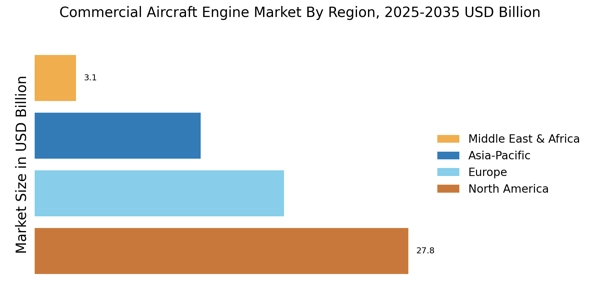The Commercial Aircraft Engine Market is currently characterized by a dynamic competitive landscape, driven by technological advancements, sustainability initiatives, and increasing demand for fuel-efficient engines. Major players such as General Electric (US), Rolls-Royce (GB), and Pratt & Whitney (US) are at the forefront, each adopting distinct strategies to enhance their market positioning. General Electric (US) focuses on innovation through its digital twin technology, which optimizes engine performance and maintenance. Meanwhile, Rolls-Royce (GB) emphasizes sustainability, investing heavily in developing hybrid-electric propulsion systems. Pratt & Whitney (US) is concentrating on expanding its GTF (Geared Turbofan) engine family, which is known for its fuel efficiency and reduced emissions, thereby appealing to environmentally conscious airlines. Collectively, these strategies not only enhance individual company profiles but also intensify competition within the market, as firms strive to meet evolving customer expectations and regulatory standards.
Key business tactics employed by these companies include localizing manufacturing and optimizing supply chains to enhance operational efficiency. The market structure appears moderately fragmented, with several key players holding substantial market shares while also facing competition from emerging firms. This fragmentation allows for a diverse range of offerings, catering to various customer needs and preferences. The collective influence of these major players shapes the market dynamics, as they engage in strategic partnerships and collaborations to bolster their capabilities and market reach.
In August 2025, General Electric (US) announced a partnership with a leading aerospace startup to develop next-generation sustainable aviation fuel (SAF) technologies. This collaboration is strategically significant as it aligns with the industry's shift towards greener solutions, potentially positioning General Electric (US) as a leader in sustainable engine technologies. The move not only enhances their product offerings but also addresses growing regulatory pressures for reduced carbon emissions in aviation.
In September 2025, Rolls-Royce (GB) unveiled its latest hybrid-electric engine prototype, which is expected to enter testing phases in early 2026. This development underscores Rolls-Royce's commitment to innovation and sustainability, as hybrid-electric systems are anticipated to play a crucial role in the future of aviation. The introduction of this technology could significantly reduce operational costs for airlines while meeting stringent environmental regulations, thereby enhancing Rolls-Royce's competitive edge.
In July 2025, Pratt & Whitney (US) secured a major contract with a prominent airline for the supply of its GTF engines, which are designed to deliver superior fuel efficiency. This contract not only solidifies Pratt & Whitney's market position but also reflects the growing demand for advanced, eco-friendly engine solutions. The strategic importance of this contract lies in its potential to drive revenue growth and reinforce customer loyalty in an increasingly competitive market.
As of October 2025, the competitive trends within the Commercial Aircraft Engine Market are increasingly defined by digitalization, sustainability, and the integration of artificial intelligence. Strategic alliances are becoming more prevalent, as companies recognize the need to collaborate in order to innovate and meet the demands of a rapidly evolving market. Looking ahead, competitive differentiation is likely to shift from traditional price-based competition to a focus on innovation, technological advancements, and supply chain reliability. This evolution suggests that companies that prioritize these aspects will be better positioned to thrive in the future landscape of the aviation industry.


















Leave a Comment